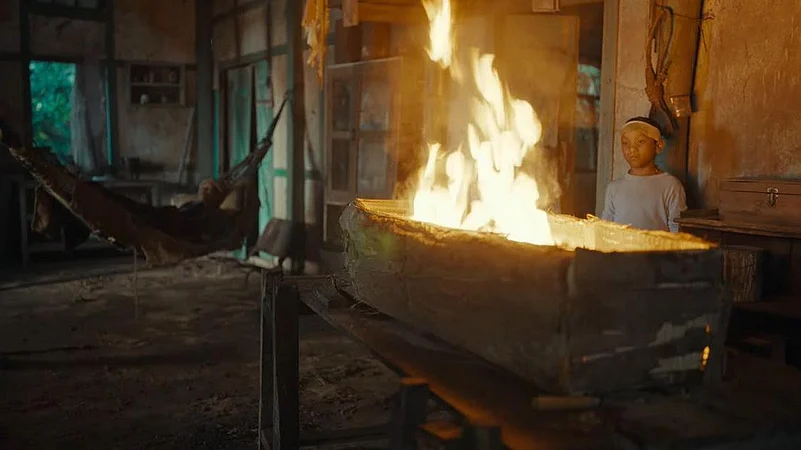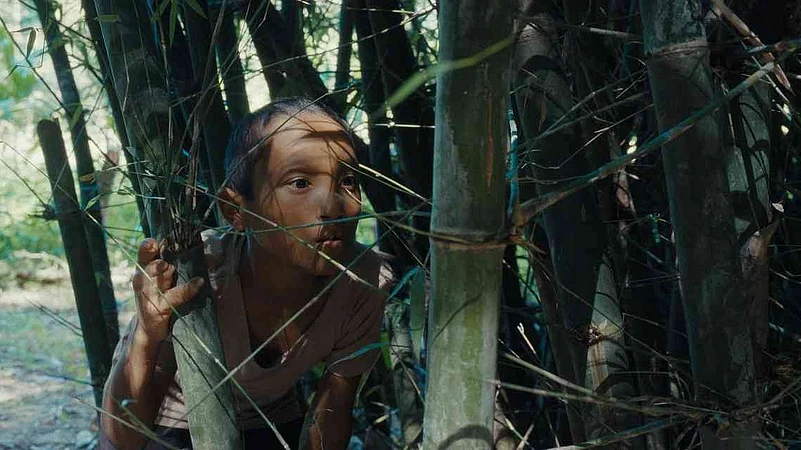Rapture (Rimdogittanga) opens to scores of villagers emerging from the cover of night, lanterns in hand bursting an opening of light that fills up the forest in frame. They are seeking a particular kind of cicadas for nourishment which, we are told, appear only once in every four years. Tojo Xavier’s camera wanders the full breadth of the area, as it does nearly throughout the film, roving from one corner to the other. There’s anticipation and eagerness in the air, the buzzing, animated sounds transmitting the eventfulness of the night, as there’s a sharp cut to a shot stuffed with the villagers’ scourings.
Director Dominic Sangma is an evocative storyteller, arguably among the most sophisticated Indian filmmakers working today who is crucially able to work with a profound understanding of local idioms and regionally specific textures. Though Rapture is just his sophomore feature, he displays all the signs of a full-fledged auteur, a distinctive voice and language which is specially honed in Meghalaya’s Garo hills, the state where he was born and raised, while being cognisant of the inflections in world cinema. There’s a deep, atmospheric evocation of a sense of place; the very terrain characters occupy seems to roil with the bouts of trouble breaking out all across the village.

Shot in the Garo hills, including the village Sangma grew up in, Nongthymmai, Rapture, unfolding from the perspective of the ten-year-old Kasan (Torikhu A. Sangma), dovetails the corrosion of innocence with the horror and sanguinary edges of unchecked irrationality. Visually and narrative-wise, the film is delineated in bracing contrasts. Two central paradigms clash-the Garo indigenous belief-system (exemplified by the figure of the shaman) and the overbearing influence of the Church. Interplay between the utter darkness of an unreasoning, morally shaky swamp and shimmering shards of truth finds visual transmission in the see-saw between light and shadow. Xavier orchestrates these interactions in magnificent, macrocosmically attentive compositions. The revealing descent of the camera’s gaze in a night-time search expedition will take your breath away.
The film is essentially a disquieting morality tale, a fable about a Garo village caught in a stranglehold of heightened fear and insular, agenda-driven absolutist narratives, which darkens as it progresses, both literally and metaphorically. The worst abscesses of men slop out,while a thickening veil of arch suspicion and inherent animosity towards any form of the alien ‘other’ shrouds the community. Multiple narratives are spun around the ‘intruders’ creeping into the village, each reflecting a skewed vested interest. All sorts of nefarious claims are hurled about. Some label the strangers as child-kidnappers, others speculate involvement in seedy organ transplant business. Hearsay, rumour and assumptions make the tight-knit community careen to a point of no return.
It’s a border village with the flush of migrants turning into inflammatory distress points for the community marooned and tipping over into a realm of paranoia and anguish. It is impossible to shove out of consideration the dramatic political registers of unease over migrants; the NRC/CAA contexts hover in close vicinity.
Meanwhile, the village pastor (Celestine K. Sangma) warns of a forthcoming apocalyptic spell that will plunge the world in absolute darkness for 40 days and nights. There’s a lot of misleading and manipulation. In the frenzy that spreads through rapidly, opportunities for level-headed contemplation and rationalising a clear way out of the fog of deceit and falsehoods are all but tossed out. With the frequently thoughtless, impetuous violence of the adult world crashing in unbidden, Kasan’s world of shielded innocence splinters. Being in the know of a killing, which all the curdled hate and distrust climaxes in, immediately puts him in a tight spot. His family is sucked into danger, the probability of eviction looming formidably, should Kasan dare to speak up about the daylight murder he witnessed. This considerably attenuates the tenacity of Kasan’s father Nengsal, who is initially more discerning and wary of the herd mentality rampant in the community, with its dodgy, deepening intolerance of the ‘other’. Circumstances hurtle towards self-destruction.
Only Sobel, the village’s coffin-maker, doesn’t brook the scurry of violent prejudice from reaching his doorstep. He stands at a hermetic remove from the mad chaos that engulfs the village. Unlike Nengsal, whose stance does shift later into compromised terrain, he is a man “of wisdom and stillness”, as Sangma himself puts it. Sobel sticks to being a mute, impassive presence. However Sangma adds, the character did have other appendages in earlier iterations of the script. For example, Sobel carried with him the whole time Dewansingh Rongmuthu Sangma’s book Jadoreng: the Psycho-physical culture of the Garos. “It is basically about how Garos can teleport themselves from one place to another and they understand a lot about other dimensions. He understands the gravitational force of planetary movements. He is calm and knows everything that’s happening in the village. Ultimately he is the one who knows the truth.”

Sangma explains how he begins a project. The visuals pop up first, which he writes and compiles in a document. Only later does he stitch them to a semblance of story and structure, once he has the impressions of certain themes he wishes to explore. He may not even be sure initially where the images can be fitted. Like the religious procession or the collecting of cicadas in the film, such sequences are tied to lived realities and casual sightings.

He mines everyday life for visuals that can sneak into his films. Dreams too become fodder, as is evident the space they accrue in his work. The entrancing dream sequence in Rapture, unrolling in a cave, pleats abstractions of afterlife, blurs boundaries between the real and the tangible while peeping into the very bedrock of Garo creeds. Sangma’s cinema is girdled in the metaphysical even as it interrogates what the lethal cocktail of fear and blinding power can trigger in a large group of people. At its heart, Rapture is about all those loose openings and cracks within dogmatic narratives and absolutist perceptions, to look past which heralds disaster.
It is now close to a year since Rapture had its world premiere at the 2023 edition of the Locarno film festival, in the Cineasti del presente section. It went on to play at a slew of festivals, scooping up the Cultural Diversity Award at Asia Pacific Screen Awards and the NETPAC prize at the MAMI Mumbai Film Festival, both in 2023. Xavier won the Best Cinematography award at the recently concluded Malaysia International Film Festival. Earlier this year, Rapture secured theatrical release in France, hitting 152 screens, a staggering feat for an Indian indie. At last, it has landed in Meghalaya.
“There was a huge cry about the film not coming home since it has been travelling worldwide. I got some negative flak too,” he says. But there is a gulf between social media chatter and people surging into theatres. Release initiatives have to doubly thought out, given Tura doesn’t have theatres. So the auditoriums demand the equipping of screens, projectors, proper sound facilities, volunteers and bouncers. In the purview of such additional logistical needs, a release couldn’t just be abruptly cobbled together.
Eve Gunme Marak, the film’s local producer, has been instrumental in mounting the concerted endeavour to host the screenings on home turf. A pre-screening was held in July to gauge the tenor of the local response. Intellectuals, artists, nuns, writers, academics were invited. They wrote glowingly about the film. Following this, the film was released in Tura on August 15. Tickets were discounted for students. Sangma went to schools and colleges. Teachers grew interested and consequently brought students. All shows were sold out subsequently. “Audiences are laughing, shouting and whistling. There’s collective pride. Our people do feel inferior comparing themselves to other parts of India”, Sangma remarks. Such occasions impart a thrilling lease of confidence. The rip-roaring reactions in Tura also stand in stark contrast to the widely established viewer slant of looking at the film at a sombre, “heavy political drama.”
The director does confess being startled by the groundswell of ecstatic reception.Would the audiences even accept this film, he thought, their palettes attuned to regular fare of Bollywood/Hollywood/Korean films? “ But they are grasping and responding to every nuance and the smallest of details. People are writing some of the most beautiful reviews. This has never happened before here. It feels like a cultural phenomenon”, he says.The widespread public embrace by his people, the swathe of love and engagement have given him a push for an expanded release. Emboldened by such responses, he is now mulling a release in Mumbai and other states. Irrespective of how effectively a wider release pans out, Rapture is a work of evocative, enduring virtuosity.


















